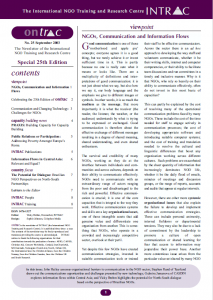 Good communication is one of those ‘motherhood and apple pie’ concepts; everyone agrees it is a good thing, but we rarely achieve it or invest sufficient time in it. This is partly because no one is really sure what it means or looks like. There are a multiplicity of definitions and interpretations of good communication: it is not just about what we say, but also how we say it, our body language and the emphasis we give to different images or symbols. In other words, it is as much the medium as the message. But more importantly it is what the receiver (the reader, the listener, the watcher, or the audience) understands by what is trying to be expressed or exchanged. Good communication is therefore about the effective exchange of different messages resulting in a degree of shared meaning, shared understanding, and even shared enthusiasm.
Good communication is one of those ‘motherhood and apple pie’ concepts; everyone agrees it is a good thing, but we rarely achieve it or invest sufficient time in it. This is partly because no one is really sure what it means or looks like. There are a multiplicity of definitions and interpretations of good communication: it is not just about what we say, but also how we say it, our body language and the emphasis we give to different images or symbols. In other words, it is as much the medium as the message. But more importantly it is what the receiver (the reader, the listener, the watcher, or the audience) understands by what is trying to be expressed or exchanged. Good communication is therefore about the effective exchange of different messages resulting in a degree of shared meaning, shared understanding, and even shared enthusiasm.
In this issue John Hailey assesses organisational barriers to communication in the NGO sector, Stephen Rand of Tearfund draws out the communications opportunities and challenges presented by new technology, Gulmira Jamanova of CASDIN explores information flows within Central Asia, and Vicky Brehm highlights the potential for North-South dialogue based on the perspective of Brazilian NGOs.
Download:
ONTRAC 25. NGOs, communication and information flows
.pdf (0.10mb)
Download:
ONTRAC 25. NGOs, communication and information flows. Chinese
.pdf (0.33mb)
Download:
ONTRAC 25. NGOs, communication and information flows. French
.pdf (0.05mb)
Download:
ONTRAC 25. NGOs, communication and information flows. Portugese
.pdf (0.05mb)
Download:
ontrac-25-russian-ngos-communication-and-information-flows-2003
.pdf (0.26mb)
Download:
ONTRAC 25. NGOs, communication and information flows. Spanish
.pdf (0.05mb)